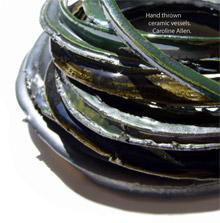Bill Crumbleholme (Beakerfolk Pottery)
Bill’s vessels are heavily influenced by prehistoric pottery, particularly Bronze Age beakers and urns. He researches processes and attempts experimentally to make these authentically and niche markets them to people who appreciate that, either archaeologists or the general public who have differing needs. How did BA potters deal with the issues of what was desirable?
Apparently prehistoric potters stuck rigidly to designs made for various functions, within limitations of available raw materials and “simple” technologies. Were their clients demanding conformity with a “norm” or were the potters coming up with the best design solution?
Beakers come in a range of shapes and sizes, with impressed decorations that follow simple design formats. Archaeologists attempt to categorise them by date and location based on differences, which pre-supposes that each type had a very tight limit on what was acceptable with users expectations. How strong was the cultural imperative forcing that lack of “creativity”?
Most modern creative artists are free to explore many types of materials and technologies and are not constrained by their audience’s traditional requirements. Was “spontaneous creativity” unacceptable to Bronze Age clients? In comparison is it actually a necessity for modern makers to uniquely distinguish their work?
To explore these questions Bill draws on his experience and perceptions as a working craftsman dealing with issues of replication of ancient artefacts and how this relates to the range and development of his more commercial products, which often reflect ancient forms.
To enhance delegates’ understanding and highlight preconceptions of categorisation choices, a selection of replica vessels and more contemporary “beakers and urns” will be displayed. Delegates will have the opportunity to physically sort them into groups of what is desirable and what is acceptable


